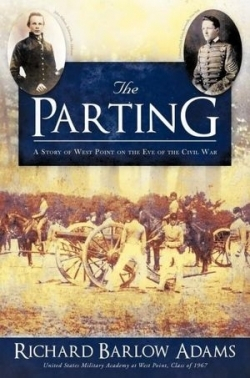
The Parting
A Story of West Point on the Eve of the Civil War
A 1967 graduate of West Point, Richard Barlow Adams captures the spirit of that grand old school for generals in his novel The Parting: A Story of West Point on the Eve of the Civil War. Several cuts above mass-market fiction on the subject, the book is written in a tone and style reminiscent of the characters and dialogue found in such classic films as Henry Hathaway’s Ten Gentlemen From West Point or John Ford’s The Long Gray Line.
Set in the year before the start of the Civil War, The Parting captures both the excitement and tension of that troubling and divisive time in American history. Although a full third of the novel is devoted to what may seem a frivolous romance between cadets and visiting college girls during a week in the summer of 1860, this element of the storyline is more than just light entertainment. It provides a scrupulous look into the way the young, privileged elite of the time comported themselves in study and play, how they treated one another, and how they viewed their world and the roles they felt required to play in it.
The romance also provides a backdrop for the real story of the book: a country and a class driven apart by conflicting loyalties and beliefs on issues of family, politics, region, and, of course, slavery. The characters’ opinions on these controversial issues drive the plot and propel the narrative through the remainder of that last, sweet summer of 1860 and into the increasingly contentious fall and winter before the outbreak of war the following spring.
Although a work of fiction, the characters in The Parting are real people (with the exception of the female romantic lead, Clara). Cadets John Pelham, Tom Rosser, Adelbert Ames, Henry du Pont, and George Armstrong Custer are well known to any student of the Civil War. They and many other cadets and teachers at West Point between 1860 and 1861 were to become the generals and heroes of the ensuing conflict. Adams has done his research and manages to make each of these men come alive throughout his narrative.
In choosing the Alabaman cadet John Pelham as his protagonist, Adams shies away from the easy or politically correct path most modern writers have taken. Pelham is an ardent defender of slavery and states’ rights, and it is his point of view that Adams presents most strongly in The Parting. Most of Pelham’s friends are fellow Southerners and are of a like mind. If there is an antagonist in the novel, it is the fire-eating abolitionist of the corps of cadets, Emory Upton. That he and Pelham somehow manage to remain friends plays to a key theme of the book: that the camaraderie forged among the brotherhood of those who wore cadet gray can survive even the greatest of conflicts.
There is one error in the book, and it comes in the very first sentence. The mistake is a small one, but glaring to those who know, study, and read about the Civil War, and it might dissuade them from reading farther. Anyone who did so would miss an otherwise excellent read. The gun referred to as a “smoothbore Napoleon ten-pounder artillery pieces” should be, rather, a twelve-pounder.
All in all, and despite the heady issues of the day, Adams’ writing is charming, entertaining, and at times even light. Other than a brief view of the battle of Bull Run, there is no blood except that drawn in a boxing match, and there is only one sex scene. Some readers might find Adams’ style overly romantic or naive, but those who share his evident nostalgia for and love of all things West Point will find The Parting a delightful yet poignant look at a generation—and a country—about to lose its innocence in the fires of civil war.
Reviewed by
Mark G. McLaughlin
Disclosure: This article is not an endorsement, but a review. The publisher of this book provided free copies of the book and paid a small fee to have their book reviewed by a professional reviewer. Foreword Reviews and Clarion Reviews make no guarantee that the publisher will receive a positive review. Foreword Magazine, Inc. is disclosing this in accordance with the Federal Trade Commission’s 16 CFR, Part 255.
